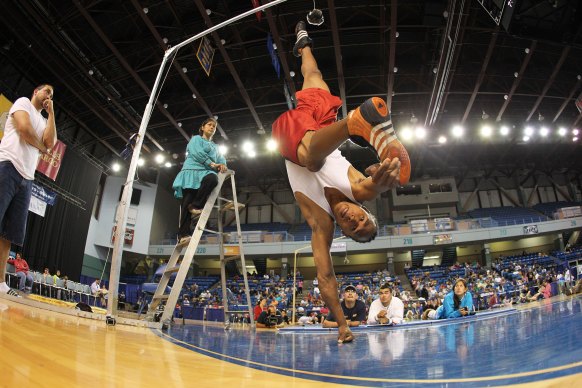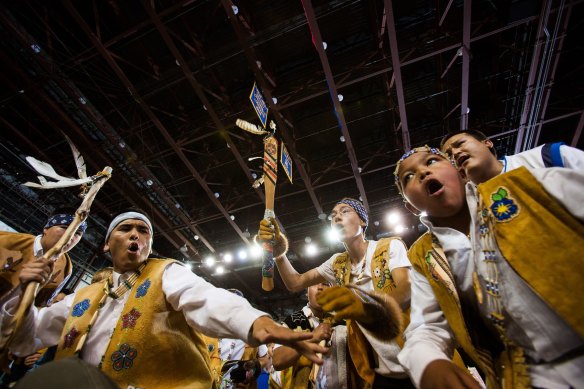Battle it out in a tug of war using ears; cut up a fish in record time; see how high one can jump on a blanket toss: if the Olympic Games needs to add new sports into the program, perhaps it should look towards the World Eskimo Indian Olympics (WEIO) for inspiration.
I’m sitting in Fairbanks’ Big Dipper Arena, attending the opening ceremony of this lesser-known Olympic games. The games have occurred yearly since 1961 in Alaska. Initially, WEIO was known as the Eskimo Olympics, involving indigenous groups across Alaska.

Ouch factor: a contestant in the Ear Pull.Credit: Alamy
In the 1970s, the name was changed to reflect the event’s broader ethnic appeal across the Americas (Native Americans) and the circumpolar north – Greenland, Siberian and Canada Inuit – to protect and promote cultural traditions.
These days, the event is held over four days every July, with last year’s event seeing 160 athletes compete. And while these international games are not affiliated with their world-famous counterpart, they have received the blessing of the International Olympic Committee (IOC) to bear the highly protected term ‘Olympic’.
WEIO board member Gina Kalloch tells me, “because the organisation (WEIO) had been using the term since 1961, they (the IOC) sort of grandfathered us in. They only requested that we change the rings in our logo to avoid confusion with the IOC’s logo.”
What games does WEIO include?

A competitor in the high kick event.Credit: Alamy
The IOC doesn’t need to worry about its northward rival: typical sporting events such as athletics, track and field or swimming are nowhere to be seen at these Olympic games. Instead, WEIO invites participants with native heritage to compete in competitions related to traditional practices and survival skills.
Flexing biceps and glutes only get participants so far with feats of strength, agility and endurance stretching further than I thought. The games include 22 tournaments with no body part going untested, from high kicks, knuckle hops, and Maktak (whale skin) eating.
Perhaps the most pain-inducing is the Ear Weight challenge. I squirm at the thought. The unusual game originates from early teachings of tolerating pain and enduring harsh Arctic conditions, including frostbite.
String loops around one ear with sacks of one pound (454 grams) weights attached to twine. Weights are to be lifted straight up without using any cheek to carry the burden, with participants attempting to walk the furthest with the lopsided load. Previous participants have walked more than 2000 feet (609 metres) with an earful. Ouch.
Not to be confused with the Ear Weight challenge is the Ear Pull. Hardly a pleasant watch to see two opponents share the discomfort, battling it out in a ‘tug-of-war’. An elastic sinew is looped over each contestant’s right ear. Tugging and pulling ensues until the band comes off the opponent’s ear or if someone surrenders due to intense pain. Double ouch.
Then there’s the fish-cutting challenge. It originates with the need for efficient cutting of large volumes of fish for drying and preservation for seasons to come.
Quick-handed participants compete on speed and neatness in removing the head and filleting a fish with the tail intact. Cardboard covers the arena floor while kneeling competitors cut salmon with an ulu (traditional Inuit all-purpose knife) or kitchen knife. It’s a razor-finish to the end, and I manage to witness a fish ready to hang dry in 26.85 seconds – a new world record.
We are all in this together

The event is a celebration of Indigenous culture.
While the Olympics is more vigorous with timing and schedules, WEIO adopts a more laidback approach, with stopwatches used and audience participation in some events.
After watching sore ears and knifework, I go to the arena floor to get involved in one of the game’s most anticipated events. The Blanket Toss, known as Nalukataq, derives from post-whaling season celebrations. It requires large audience participation, with 40-50 adults holding on to the framework of the ‘blanket’ – akin to a trampoline.
The blanket is traditionally made from bearded seal skin or walrus hide with hairs removed. Volunteers act as the springs with immense strength required to toss a participant the highest. The aim is to have jumpers land on their feet with good form and grace, a feat most likely achieved if the pullers can evenly level the blanket.
I am happy to take on a role as a human spring, but I quickly realise how intense it is. I’m not even competing; I wear myself out alongside others, thrusting a competitor to new heights to win gold.
But it’s more than seeing who reigns supreme on the podium for these games. WEIO also celebrates the arts and pageantry with two regalia competitions, a showy Miss WEIO Pageant and dance competition.

The blanket toss requires audience participation. Credit: Alamy
“The most important impact is that these events are passed down to younger generations,” says Kalloch.
“With the encroachment of the dominant culture, native traditions were in danger of being lost. It is also a wonderful way for native peoples to share cultures with each other and with others from around the world.”
These games may seem different from the ones we know, but the spirit of humanity, cooperation, and tenacity remains the same (perhaps minus the ouch factor).
Details
The Olympics runs from July 12 - 15, 2023.
Admission to the Olympics is free for daytime events. From 6pm, tickets for adults are $US15 ($22.50), seniors and children $US10. See weio.org
Julia D’Orazio was a guest of Explore Fairbanks.
Sign up for the Traveller Deals newsletter
Get exclusive travel deals delivered straight to your inbox. Sign up now.